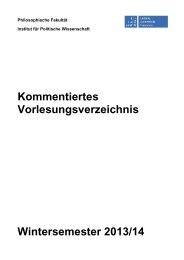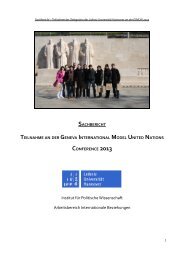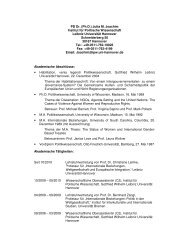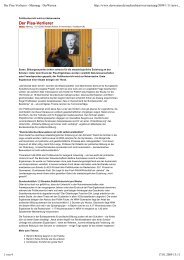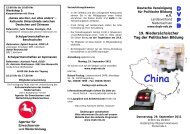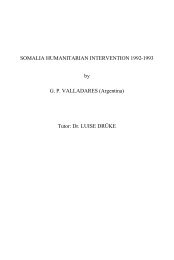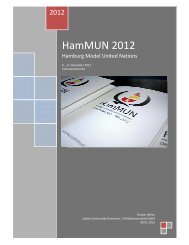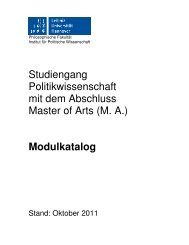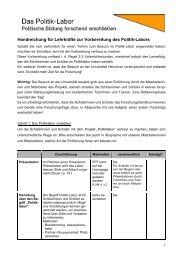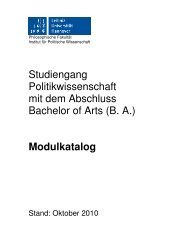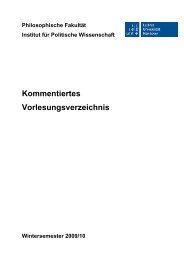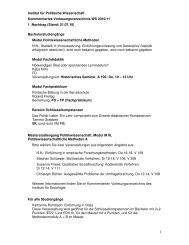Preventive Action for Refugee Producing Situations
Preventive Action for Refugee Producing Situations
Preventive Action for Refugee Producing Situations
You also want an ePaper? Increase the reach of your titles
YUMPU automatically turns print PDFs into web optimized ePapers that Google loves.
98 Chapter 3<br />
a) Vietnam was unwilling to take any Vietnamese back (in any case, there<br />
seemed to be very few persons who would have voluntarily chosen to<br />
return to Vietnam).<br />
b) First-asylum countries were still only minimally familiar with customary<br />
laws of asylum and the general principle of non-refoulement This lack of<br />
experience brought about serious violations of international law, especially<br />
in Malaysia, but also in Thailand and Singapore, in the <strong>for</strong>m of push-offs<br />
onto the high seas on often un-seaworthy boats, causing untold harm to<br />
thousands of seeking to land. Under these circumstances, screening would<br />
probably have antagonized the ASEAN countries and Hong Kong, who<br />
feared getting stuck with the ineligible residual caseload of rejected people.<br />
c) The massive influx of asylum seekers severely challenged capacity of<br />
UNHCR to cope with emergency protection and assistance issues. Anything<br />
other than simple resettlement registration <strong>for</strong> starting resettlement<br />
processing would at that time have overtaxed its existing structures in the<br />
region.215 Because their lives were at stake, both during flight and in the<br />
process of entering a country of refuge, UNHCR's objective was to arrange<br />
resettlement as speedily as possible. Quick resettlement became a physical<br />
means of protection. In addition, the political context was grim. Setting up a<br />
screening process and negotiating <strong>for</strong> repatriation of persons not qualifying<br />
as refugees did not seem to have bright prospects, and neither Vietnamese<br />
nor U.S. authorities at that time seemed ready <strong>for</strong> it. There<strong>for</strong>e ef<strong>for</strong>ts in<br />
this direction were not a top priority.<br />
d) Until the 1979 meeting, UNHCR employed the term "Vietnamese<br />
displaced person" (VNDPs) <strong>for</strong> the boat people. 216 Only slowly thereafter<br />
did all arrivals started to be called "refugees." In light of UNHCR's<br />
preexisting operation on behalf of displaced persons within Vietnam, the<br />
assistance program in first-asylum countries seemed to be an extended arm<br />
of the preexisting program<br />
__________________________<br />
215 In September 1978,1 went on a one-week mission to the East Coast of<br />
Malaysia (Pulau Tengha, an island one hour offshore from Mersing, north of<br />
Singapore), with the objective to interview nearly 6000 new arrivals. Even<br />
though working from 7:00 a.m. until late at night to register some 800 persons<br />
a day, proper screening would have required not only more resettlement staff<br />
but also protection officers <strong>for</strong> <strong>for</strong>mal determination of eligibility. UNHCR<br />
was not equipped at that time <strong>for</strong> this task.<br />
216 See UN doc A/34/627, "1979 Meeting on <strong>Refugee</strong>s in SEA," 7 November<br />
1979.<br />
Analytical Discussion 99<br />
within Vietnam, and so the implementation of a screening procedure<br />
seemed unnecessary.<br />
Though the 1979 Meeting was successful in terms of immediate results, I<br />
believe that the following issues should also have been raised at that time<br />
with the Vietnamese authorities:<br />
a) screening of new arrivals; and<br />
b) exploring solutions <strong>for</strong> those found outside of<br />
UNHCR's competence, including their return to Vietnam under internationally<br />
agreed-upon and safe conditions. 217 Rather than negotiating a fair<br />
sharing of the burden with Vietnam, all energies were directed toward<br />
handling the result of Vietnam's arbitrary policy, 218 regardless of the actual<br />
motivation that caused people to leave the country. The U.S.A. advocated a<br />
policy of international burden-sharing, but Vietnam's non-cooperation<br />
seems to have been seen as an insurmountable obstacle to direct<br />
negotiation. Without addressing the problems that caused people to leave<br />
Vietnam, the 1979 meeting nonetheless produced a magnet in terms of<br />
attracting money, 219 resettlement places, international public attention and<br />
compassion, and mobilization of the various states (except Vietnam). In the<br />
early 1980s, however, the euphoric willingness to make resettlement places<br />
available started to dwindle, and "compassion fatigue" set in. Even so, still<br />
no screening nor repatriation projects were seriously considered.<br />
Because Vietnam has recently agreed, <strong>for</strong> the first time, to the voluntary<br />
repatriation of approximately 9,500 Vietnamese boat people who were not<br />
accepted by rejected by the British authorities in Hong Kong, 220<br />
________________________<br />
217 It was nearly ten years later that provisions of this type were agreed upon.<br />
See Memorandum of Understanding between the Socialist Republic of<br />
Vietnam and UNHCR which was signed on 13 December 1988 in Geneva<br />
(see in the appendices). This agreement includes plans of sreening of new<br />
arrivals, and the repatriation of Vietnamese citizen on a voluntary basis.<br />
218 There was a backlog of over 300,000 persons in camps in Southeast Asia<br />
who were awaiting a durable solution. A higher monthly rate of departure <strong>for</strong><br />
resettlement was to be the first step of the solution. See UN doc A/34/621,<br />
"1979 Meeting on <strong>Refugee</strong>s in SEA," Background note dated 9 July 1979, in<br />
Annex I, p. 8.<br />
219 UNHCR's expenditures jumped from $206,995,000 in 1979 to $496,956,000<br />
in 1980. In<strong>for</strong>mation Paper UNHCR, Geneva, April 1987.<br />
220 "Vietnam, in Flurry of Moves, Pushes <strong>for</strong> Better Ties to U.S.," The New<br />
York Times, October 17,1988.



